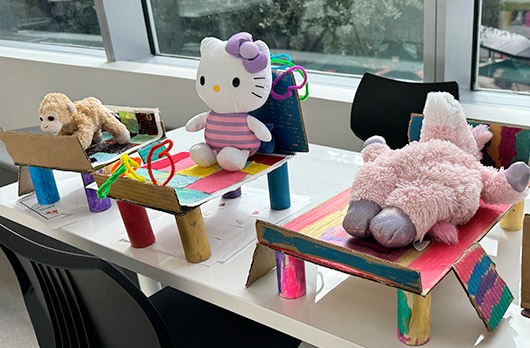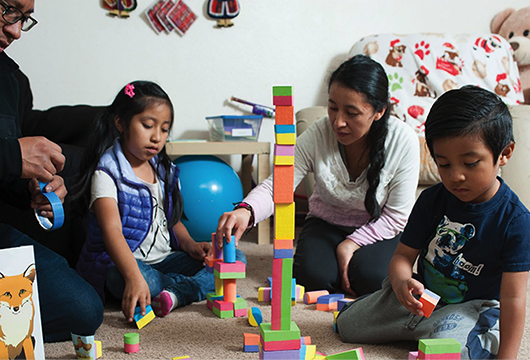TERC Blog
Engaging Engineering Design Challenge for Kids
The Animals Would Not Sleep
By: Sara Levine / Illustrated by: Marta Álvarez Miguéns
What would a scientist do?
 It’s bedtime, and Marco’s toys are causing a ruckus and won’t settle down. But as a scientist, Marco can’t just put his toys away, he needs to sort them. He tries many ways: swimming animals, land animals, flying animals; black and white animals, brown animals, colorful animals; big animals, small animals. Nothing seems to work to help the animals sleep. Marco observes, compares, and groups, but the animals refuse every classification. Finally, he combines math with empathy to get the most important result: maximum snuggles.
It’s bedtime, and Marco’s toys are causing a ruckus and won’t settle down. But as a scientist, Marco can’t just put his toys away, he needs to sort them. He tries many ways: swimming animals, land animals, flying animals; black and white animals, brown animals, colorful animals; big animals, small animals. Nothing seems to work to help the animals sleep. Marco observes, compares, and groups, but the animals refuse every classification. Finally, he combines math with empathy to get the most important result: maximum snuggles.
One teacher, Jenny Diaz, has taken this Storytelling Math book a step further and built an engineering design challenge around it. In this challenge, students will embark on a journey to create a comfortable bed for their stuffed animal friend. By applying their problem-solving skills and design thinking, they will learn valuable lessons in engineering and have fun in the process. Below is a summary of her lesson plan that we encourage others to do with their students!
“I'm passionate about the Storytelling books, which significantly impact my students' learning."
—Jenny Diaz
Introduction to the Project: Classification and Sorting
Students will classify and sort stuffed animals using various criteria, such as animal/non-animal, color, shape, size, and texture. Teachers will put a stuffed animal in a Mystery Box and students will ask questions to guess the item in the bag. This activity is designed to help students develop their observational and categorization skills by classifying and sorting stuffed animals based on various criteria such as animal/non-animal, color, shape, size, and texture. Additionally, it will introduce students to data collection and representation by having them create a graph based on a specific characteristic, such as the most popular color or type of animal.

Teachers will then have students write an "I Need" letter to take home, asking parents permission to bring a stuffed animal to school to foster communication and collaboration between students and their families.
Engineering Design Challenge

To kick off the challenge, the students will listen to the read-aloud story 'Animals Won't Sleep' and engage in a discussion about how to make their stuffed animal friend more comfortable at night. This will set the stage for their creative brainstorming and sketching of bed designs.
Problem-Solving and Design
In this phase of the challenge, students will dive deeper into problem-solving and design. They will explore different ideas and strategies to make their stuffed animal friend's bed as comfortable as possible. Through discussions and collaboration, they will learn to think critically and come up with innovative solutions. This stage is all about nurturing their creativity and encouraging them to think outside the box.
Measurement and Scaling
To ensure that the bed is the perfect fit for their stuffed animal friend, students will engage in measuring and scaling activities. They will explore various non-standard measurement units such as unifix cubes, popsicle sticks, paper clips, or even their arm. These units will be used to measure the width and length of their stuffed animals, allowing them to create accurate and proportionate bed designs. This hands-on experience will help them develop their spatial awareness and mathematical skills.


Model Building and Planning
 Once the measurements are done, students will move on to the model building and planning phase. Using unifix cubes, they will construct a model of their bed design. This model will serve as a visual representation of their ideas and will help them in the next steps of the process. They will trace the model onto paper, label the side lengths, and add details to their plan. This step will enhance their visualization and planning skills, as well as their ability to communicate their ideas effectively.
Once the measurements are done, students will move on to the model building and planning phase. Using unifix cubes, they will construct a model of their bed design. This model will serve as a visual representation of their ideas and will help them in the next steps of the process. They will trace the model onto paper, label the side lengths, and add details to their plan. This step will enhance their visualization and planning skills, as well as their ability to communicate their ideas effectively.
Construction and Decoration
 Now it's time to bring the bed to life! Students will begin the construction process by making a quilt and pillow for their stuffed animal friend. This will add a cozy touch to the bed and make it even more comfortable. They will also focus on constructing the bed frame, which includes elements like four-bed posts, a platform, a headboard, and a footboard. By investigating different bed creatures and components, they will gain insights into the structural aspects of bed construction.
Now it's time to bring the bed to life! Students will begin the construction process by making a quilt and pillow for their stuffed animal friend. This will add a cozy touch to the bed and make it even more comfortable. They will also focus on constructing the bed frame, which includes elements like four-bed posts, a platform, a headboard, and a footboard. By investigating different bed creatures and components, they will gain insights into the structural aspects of bed construction.
Culminating Event
Students will showcase their creations at an event for their families and/or school members. They will unveil the stuffed animal beds in an environment accompanied by lullaby music and soft lights. This event will give students the opportunity to thoughtfully explain their design thinking process, math principles, materials selected, and any challenges they had to overcome.



* The kindergarten teachers, math coach, and math consultant collaborated closely on this project to ensure the students received guidance and support throughout the challenge.
A special thank you to Jenny Diaz for allowing TERC to share her lesson plan with our community. We hope it inspires others to implement it in their schools/after school settings. If you've used the Storytelling Math books to engage the learners in your life, we'd love to hear your stories. Please send us a message here.
"The Animals Would Not Sleep" is also available in Spanish.
Storytelling Math books offer a wide range of math topics, feature main characters of color, appeal to a broad audience, and are written by a diverse array of authors. Read more about the project and the research here.
The Storytelling Math series can be purchased from Charlesbridge Publishing.









